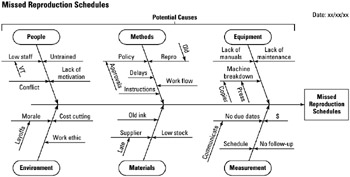Tool 25: Cause and Effect Diagram (CED)
| AKA | Fishbone Diagram, Ishikawa Diagram |
| Classification | Analyzing/Trending (AT) |
Tool description
The cause and effect diagram is a fishbone diagram that typically displays major, generic categories such as people, methods, materials, equipment, measurement, and environment that cause an effect, often perceived as a problem. First applied by Kaoru Ishikawa in 1950, this diagram is used to systematically analyze cause and effect relationships and to identify potential root causes of a problem.
Typical application
-
To assist a team to reach a common understanding of a complex problem.
-
To expand the team's thinking and consider all potential causes.
-
To define the major categories or sources of root causes.
-
To organize and analyze relationships and interactive factors.
-
To identify factors that could improve a process.
Problem-solving phase
| → | Select and define problem or opportunity |
| → | Identify and analyze causes or potential change |
| Develop and plan possible solutions or change | |
| Implement and evaluate solution or change | |
| Measure and report solution or change results | |
| Recognize and reward team efforts |
Typically used by
| Research/statistics | |
| Creativity/innovation | |
| Engineering | |
| Project management | |
| 3 | Manufacturing |
| Marketing/sales | |
| Administration/documentation | |
| 2 | Servicing/support |
| 4 | Customer/quality metrics |
| 1 | Change management |
before
-
Brainstorming
-
Five Whys
-
Brainwriting Pool
-
5W2H method
-
6-3-5 Method
after
-
Problem Specification
-
Work Flow Analysis (WFA)
-
Pareto Chart
-
Countermeasures Matrix
-
Problem Analysis
Notes and key points
-
Generic category designation may be substituted. Example: "procedures" for "methods," or "facilities" for "equipment," etc.
-
Do not overload categories. Establish another category if more detail is desired.
Step-by-step procedure
-
STEP 1 Reach consensus on a problem to be analyzed. See example Missed Reproduction Schedules.
-
STEP 2 Determine the major categories and place one in each category box.
-
STEP 3 Brainstorm possible causes for each category and enter them in a fishbone fashion by drawing arrows to the main arrow (category) as shown in the example.
-
STEP 4 Continue to ask questions using the Five Whys tool to search for root causes. Insert and connect potential causes to the various other contributing factors.
-
STEP 5 When ideas or causes can no longer be identified, further analyze the diagram to identify additional data collection requirements for problem solving.
Example of tool application

EAN: 2147483647
Pages: 326